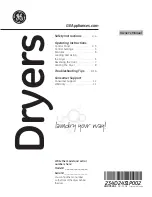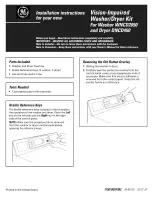
9
Flush water supply line
4
Slowly turn water shutoff valve to “ON” position. Flush
water into a shallow pan until clear to get rid of particles
that could clog the inlet valve. Turn shutoff valve to
“OFF” position.
Drill hole
1
1 1/2”
(3.8 cm)
If needed, drill a 1 1/2” (3.8 cm) diameter hole in cabinet
wall or side of the opening closest to the sink.
Connect drain hose to waste tee or waste disposer
using one of the following options:
• Option A, Waste disposer – no air gap
• Option B, No waste disposer – no air gap
• Option C, Waste disposer – with air gap
• Option D, No waste disposer – with air gap
Connect drain hose
3
Install Drain Hose
IMPORTANT:
Always use a new drain hose. Check local
codes to determine if an air gap is required.
Large silver
drain hose clamp
Drain hose
Drain trap
Drain trap
Disposer inlet
Disposer inlet
Waste disposer – no air gap
1. Using a hammer and screwdriver,
knock plug into disposer.
2. Use needle-nose pliers to remove
plug.
3. Attach drain hose to disposer inlet
with large silver drain hose clamp
(provided). Use pliers to squeeze
clamp open and move into position.
1
3
2
Option A, Waste disposer – no air gap
Drain hose
Route drain hose
2
Route drain hose as shown through hole in cabinet to the
front center of opening where drain connection will be
made. Tape drain hose to the floor in area shown. This will
prohibit it from moving when dishwasher is moved into
cabinet opening.
IMPORTANT:
The drain hose connection of the disposer or
a waste tee must be made before the drain trap and at
least 20” (50.8 cm) above the floor where the dishwasher
will be installed.
Helpful Tip:
To reduce vibration of the hose, keep the hose
away from the floor.
Route water supply line
3
Slowly route water supply line through hole in cabinet.
(If using copper tubing, it will bend and kink easily, so be
gentle.) It should be far enough into the cabinet opening
to connect it to the dishwasher inlet on the front left
side of the dishwasher.










































